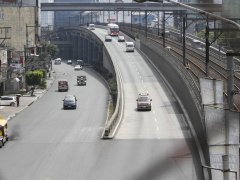News
Build, Build, Build’ to cut down traffic in Metro Manila: DPWH

Aside from reducing travel time, the “Build, Build, Build” program aims to improve the road quality and safety by widening roads and bridges. (PNA photo)
MANILA — With the “Build, Build, Build” infrastructure program’s big ticket projects now underway, the public can now expect the traffic in Metro Manila to decongest every year, according to the Department of Public Works and Highways (DPWH).
In a Palace press briefing, DPWH Secretary Mark Villar said all systems are going for the implementation of major infrastructure projects particularly roads and bridges, not only in the National Capital Region, but throughout the country.
“Every year, there will be improvement, that we can guarantee and it’s really our goal by the end of the term of our President is decongest Metro Manila,” Villar said.
A 10-minute video presentation highlighted the DPWH’s 18 more expressway networks to be constructed throughout the country and 12 bridges along Pasig and Marikina rivers.
Villar said by-passed roads such as the Metro Manila Skyway and the North Luzon Expressway-South Luzon Expressway connector are expected to reduce traffic along congested EDSA once completed in 2022.
“Our objective is to reduce the clogged arteries not only in Metro Manila but in all major urban centers of our country by the end of the term of our President (Rodrigo Duterte),” he said.
Aside from reducing travel time, the “Build, Build, Build” program aims to improve the road quality and safety by widening roads and bridges.
The massive infrastructure program also aims to protect homes and properties from natural disasters by building at least 49 flood control projects.
Villar said over 100,000 jobs have been created in just first year of the implementation of the “Build, Build, Build” program by the Duterte administration.
The program also pushed government spending and infrastructure and other capital outlays to a high 25.2 percent year-on-year, reaching a total of PHP43.3 billion for January.
According to the Department of Budget and Management (DBM), the increase was driven by the completed school building, flood control, lahar control and climate mitigation projects.
“It is unprecedented in the history of country. It’s the largest infrastructure (Build, Build, Build) program,” Villar said.
Under the Duterte administration, Villar said the first year alone has shown 5.2 percent of the gross domestic product (GDP) spent on infrastructure, outpointing the previous administration’s nearly 3 percent.
“This year, it increases to 6 percent of GDP. In fact last year our obligation or absorptive capacity reached a record high of 92 percent. This is the highest in the history of the DPWH,” he said.
Villar has recognized China, Japan and Korea for supporting the Duterte’s “Build, Build, Build” program described by many as golden age of the country’s infrastructure development.





















